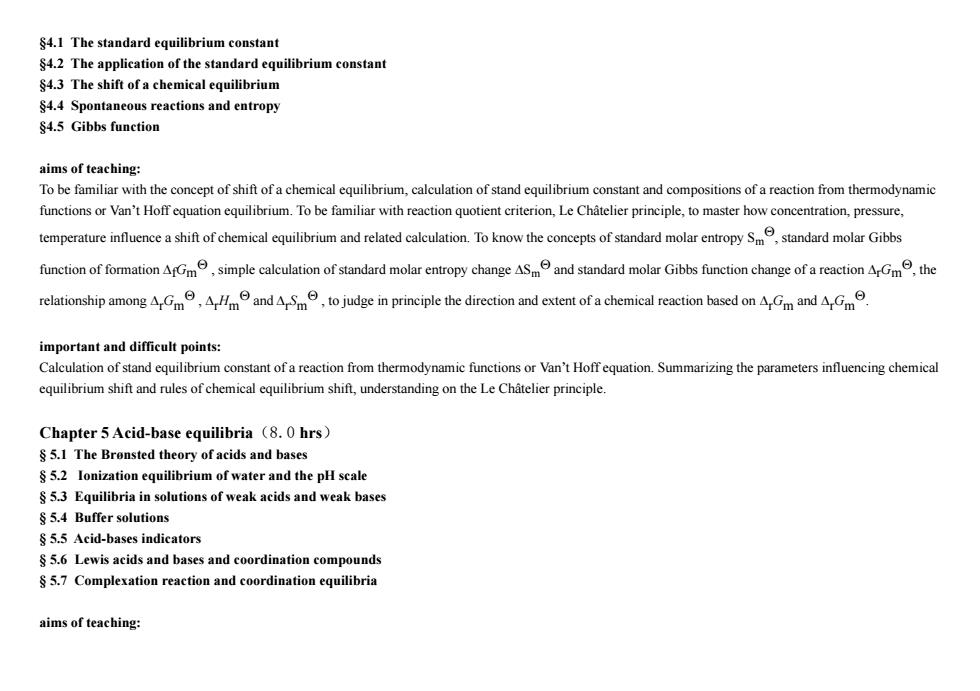正在加载图片...

$4.1 The standard equilibrium constant $4.2 The application of the standard equilibrium constant $4.3 The shift of a chemical equilibrium $4.4 Spontaneous reactions and entropy $4.5 Gibbs function aims of teaching: To be familiar with the concept of shift of a chemical equilibrium,calculation of stand equilibrium constant and compositions of a reaction from thermodynamic functions or Van't Hoff equation equilibrium.To be familiar with reaction quotient criterion,Le Chatelier principle,to master how concentration,pressure, temperature influence a shift of chemical equilibrium and related calculation.To know the concepts of standard molar entropy Sstandard molar Gibbs function of formation AGm,simple calculation of standard molar entropy change ASand standard molar Gibbs function change of a reaction ArGm,the relationship amongandStojudge in principle the direction and extent of a chemical reaction based onandA important and difficult points: Calculation of stand equilibrium constant of a reaction from thermodynamic functions or Van't Hoff equation.Summarizing the parameters influencing chemical equilibrium shift and rules of chemical equilibrium shift,understanding on the Le Chatelier principle. Chapter 5 Acid-base equilibria (8.0 hrs) 5.1 The Brensted theory of acids and bases $5.2 Ionization equilibrium of water and the pH scale 5.3 Equilibria in solutions of weak acids and weak bases 5.4 Buffer solutions 5.5 Acid-bases indicators 5.6 Lewis acids and bases and coordination compounds 5.7 Complexation reaction and coordination equilibria aims of teaching: §4.1 The standard equilibrium constant §4.2 The application of the standard equilibrium constant §4.3 The shift of a chemical equilibrium §4.4 Spontaneous reactions and entropy §4.5 Gibbs function aims of teaching: To be familiar with the concept of shift of a chemical equilibrium, calculation of stand equilibrium constant and compositions of a reaction from thermodynamic functions or Van’t Hoff equation equilibrium. To be familiar with reaction quotient criterion, Le Châtelier principle, to master how concentration, pressure, temperature influence a shift of chemical equilibrium and related calculation. To know the concepts of standard molar entropy Sm Q, standard molar Gibbs function of formation DfGm Q , simple calculation of standard molar entropy change DSm Q and standard molar Gibbs function change of a reaction DrGm Q, the relationship among DrGm Q , DrHm Q and DrSm Q , to judge in principle the direction and extent of a chemical reaction based on DrGm and DrGm Q. important and difficult points: Calculation of stand equilibrium constant of a reaction from thermodynamic functions or Van’t Hoff equation. Summarizing the parameters influencing chemical equilibrium shift and rules of chemical equilibrium shift, understanding on the Le Châtelier principle. Chapter 5 Acid-base equilibria(8.0 hrs) § 5.1 The Brønsted theory of acids and bases § 5.2 Ionization equilibrium of water and the pH scale § 5.3 Equilibria in solutions of weak acids and weak bases § 5.4 Buffer solutions § 5.5 Acid-bases indicators § 5.6 Lewis acids and bases and coordination compounds § 5.7 Complexation reaction and coordination equilibria aims of teaching: